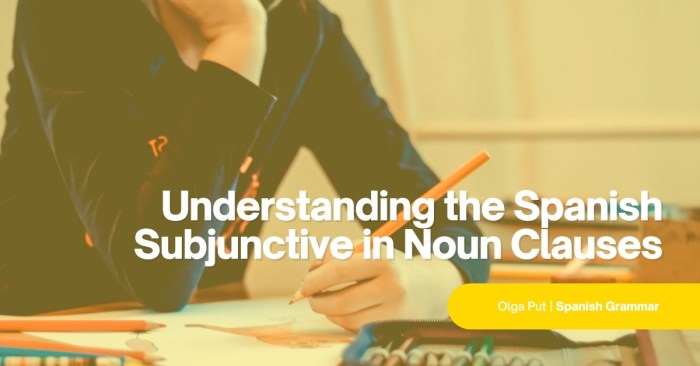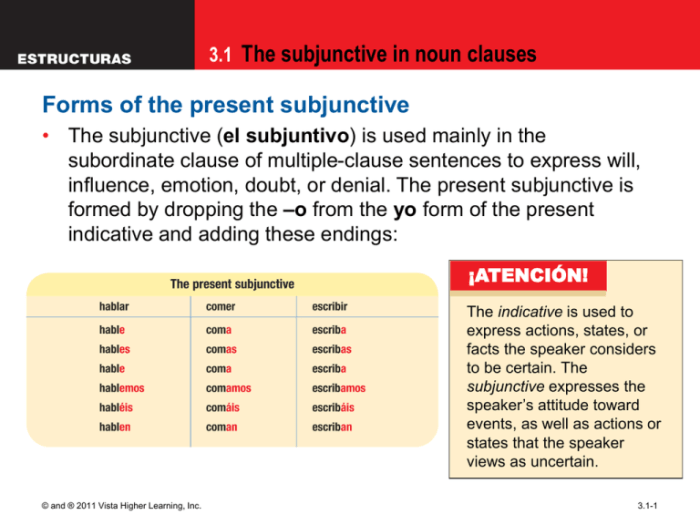Spanish subjunctive in noun clauses – Delving into the intricate realm of Spanish grammar, we embark on an exploration of the subjunctive mood in noun clauses. This grammatical phenomenon, employed to express uncertainty, subjectivity, or hypothetical situations, plays a pivotal role in shaping the meaning and structure of Spanish sentences.
As we navigate this linguistic landscape, we will uncover the diverse types of noun clauses that trigger the subjunctive, delve into the intricacies of subjunctive forms and their usage, and scrutinize the specific verbs and expressions that demand its presence.
Through a comparative analysis with other languages, we will gain a deeper understanding of the unique characteristics of the Spanish subjunctive in noun clauses.
Introduction
The Spanish subjunctive is a verb mood used to express a variety of ideas, including doubt, uncertainty, possibility, and desire. In noun clauses, the subjunctive is used to express a subjective or uncertain opinion or statement.Noun clauses are dependent clauses that function as nouns.
They can be used as the subject, object, or complement of a sentence. When a noun clause is used as the subject or complement of a sentence, the verb in the noun clause is typically in the indicative mood. However, when a noun clause is used as the object of a verb of opinion, emotion, or doubt, the verb in the noun clause is typically in the subjunctive mood.
Types of Noun Clauses

Noun clauses that trigger the subjunctive mood fall into various categories, each requiring specific subjunctive forms.
Purpose Clauses
Purpose clauses express the reason or purpose for an action and are introduced by para que(in order that) or a fin de que(so that). They use the present subjunctive.
- Estudiamos mucho para que podamos graduarnos.(We study hard so that we can graduate.)
- Trabajamos duro a fin de que nuestra familia esté cómoda.(We work hard so that our family is comfortable.)
Result Clauses
Result clauses indicate the result of an action and are introduced by de manera que(so that), de modo que(so that), or tan… que(so… that). They use the present subjunctive.
- Habla tan rápido que no puedo entenderle.(He speaks so fast that I can’t understand him.)
- La película fue tan aburrida de manera que me dormí.(The movie was so boring that I fell asleep.)
Conditional Clauses
Conditional clauses express a condition that must be met for an action to occur and are introduced by si(if). They use the present subjunctive in the dependent clause.
- Si estudias mucho, aprobarás el examen.(If you study hard, you will pass the exam.)
- Si llueve, no iremos al parque.(If it rains, we won’t go to the park.)
Comparative Clauses
Comparative clauses compare two actions or qualities and are introduced by más… que(more… than), menos… que(less… than), tan… como(as… as), or igual… que(as… as).
They use the present subjunctive in the dependent clause.
- María es más inteligente que Juan.(Maria is more intelligent than John.)
- El libro es tan interesante como la película.(The book is as interesting as the movie.)
Subjunctive Forms
The Spanish subjunctive mood has three main forms: present, imperfect, and future. Each form has its own unique set of conjugation rules and usage guidelines.
The present subjunctive is used to express actions or states that are desired, requested, or uncertain. It is also used in clauses that express emotions or opinions. The imperfect subjunctive is used to express actions or states that were desired, requested, or uncertain in the past.
It is also used in clauses that express hypothetical situations or contrary-to-fact statements. The future subjunctive is used to express actions or states that will be desired, requested, or uncertain in the future.
Present Subjunctive
- The present subjunctive is formed by dropping the -ar, -er, or -ir ending of the infinitive and adding the following endings:
- -e (for -ar verbs)
- -a (for -er and -ir verbs)
For example:
- hablar (to speak) -> hable (that I speak)
- comer (to eat) -> coma (that I eat)
- vivir (to live) -> viva (that I live)
Imperfect Subjunctive
- The imperfect subjunctive is formed by dropping the -ar, -er, or -ir ending of the infinitive and adding the following endings:
- -ara (for -ar verbs)
- -iera (for -er verbs)
- -iera (for -ir verbs)
For example:
- hablar (to speak) -> hablara (that I would speak)
- comer (to eat) -> comiera (that I would eat)
- vivir (to live) -> viviera (that I would live)
Future Subjunctive
- The future subjunctive is formed by dropping the -ar, -er, or -ir ending of the infinitive and adding the following endings:
- -are (for -ar verbs)
- -iere (for -er verbs)
- -iere (for -ir verbs)
For example:
- hablar (to speak) -> hablare (that I will speak)
- comer (to eat) -> comiere (that I will eat)
- vivir (to live) -> viviere (that I will live)
Triggering Verbs and Expressions

Certain verbs and expressions in Spanish trigger the use of the subjunctive mood in noun clauses. These verbs and expressions typically express:
- Emotions or feelings
- Opinions or beliefs
- Doubts or uncertainties
- Desires or requests
The following table lists some common triggering verbs and expressions, along with their specific requirements and exceptions:
| Verb or Expression | Requirement | Exception |
|---|---|---|
| alegrarse (de que) | Expresses joy or happiness | None |
| esperar (que) | Expresses hope or expectation | None |
| lamentar (que) | Expresses regret or sorrow | None |
| sentir (que) | Expresses a feeling or emotion | None |
| creer (que) | Expresses a belief or opinion | None |
| dudar (de que) | Expresses doubt or uncertainty | None |
| negar (que) | Expresses denial | None |
| pedir (que) | Expresses a request or demand | None |
| recomendar (que) | Expresses a recommendation | None |
| sugerir (que) | Expresses a suggestion | None |
It’s important to note that not all verbs and expressions that fall into these categories will always trigger the subjunctive. The context and specific usage of the verb or expression will determine whether the subjunctive is required.
Examples and Usage
The subjunctive mood is used in noun clauses to express a variety of meanings, including uncertainty, possibility, desire, and necessity. Here are some real-life examples of noun clauses using the subjunctive:
Declarative Statements
Declarative statements using the subjunctive express a fact or opinion that is presented as subjective or uncertain.
- Example: Es importante que todos respetemos las reglas.(It is important that everyone respects the rules.)
- Explanation:The noun clause “que todos respetemos las reglas” expresses the speaker’s opinion that it is important for everyone to respect the rules.
Interrogative Statements
Interrogative statements using the subjunctive express a question or request for information.
- Example: ¿Es posible que haya un examen mañana?(Is it possible that there will be an exam tomorrow?)
- Explanation:The noun clause “que haya un examen mañana” expresses the speaker’s question about the possibility of an exam tomorrow.
Exclamatory Statements
Exclamatory statements using the subjunctive express strong emotions or reactions.
- Example: ¡Qué bueno que hayas venido!(How good that you came!)
- Explanation:The noun clause “que hayas venido” expresses the speaker’s joy at the person’s arrival.
Imperative Statements, Spanish subjunctive in noun clauses
Imperative statements using the subjunctive express a command or request.
- Example: Es necesario que estudies para el examen.(It is necessary that you study for the exam.)
- Explanation:The noun clause “que estudies para el examen” expresses the speaker’s command for the person to study for the exam.
Conditional Statements
Conditional statements using the subjunctive express a condition or hypothesis.
- Example: Si tuviera más tiempo, viajaría más.(If I had more time, I would travel more.)
- Explanation:The noun clause “si tuviera más tiempo” expresses the condition that the speaker would travel more if they had more time.
Exceptions and Special Cases: Spanish Subjunctive In Noun Clauses
While the subjunctive is typically used in noun clauses, there are a few exceptions where it is not employed. These exceptions occur in specific scenarios where the content of the noun clause is considered factual or certain, rather than uncertain or hypothetical.
Objective Statements
When the noun clause expresses an objective fact or a statement that is not open to doubt, the indicative mood is used instead of the subjunctive. For example:
- Creo que es cierto.(I believe it is true.)
- Es evidente que no tiene razón.(It is clear that he is wrong.)
In these examples, the statements within the noun clauses are presented as objective truths, so the indicative mood is appropriate.
Clauses with “Que”
In certain cases, noun clauses introduced by the conjunction “que” (that) do not use the subjunctive if the main verb expresses a mental state, such as knowing, understanding, or believing. For example:
- Sé que estás cansado.(I know you are tired.)
- Entiendo que tienes problemas.(I understand that you have problems.)
In these examples, the main verbs “saber” (to know) and “entender” (to understand) express mental states, and the content of the noun clauses is presented as factual, so the indicative mood is used.
Reported Speech
When reporting someone’s speech, the subjunctive is not used in the noun clause if the original speaker made a statement that was presented as a fact. For example:
Dijo que era inocente.(He said he was innocent.)
In this example, the original speaker made a statement of fact, so the indicative mood is used in the reported speech.
Other Exceptions
Other exceptions to the use of the subjunctive in noun clauses include:
- Noun clauses that function as direct objects of certain verbs, such as “decir” (to say) and “pedir” (to ask).
- Noun clauses that express commands or requests.
- Noun clauses that are used as subject complements.
It is important to note that these exceptions are specific to certain contexts and constructions, and the general rule of using the subjunctive in noun clauses still applies in most cases.
Comparative Analysis
The Spanish subjunctive in noun clauses shares similarities and exhibits differences when compared to its usage in other languages.
In many languages, including English, the subjunctive is used to express hypothetical, uncertain, or desired situations. In Spanish, the subjunctive in noun clauses serves a similar function, indicating that the content of the clause is not factual or certain.
Similarities
- The subjunctive is used to express subjectivity, doubt, or uncertainty.
- In both Spanish and English, the subjunctive can be used in noun clauses introduced by certain conjunctions, such as “that” or “if.”
Differences
- In Spanish, the subjunctive is used more frequently than in English, appearing not only in noun clauses but also in other types of clauses.
- The specific triggers for the subjunctive vary across languages. In Spanish, the subjunctive is triggered by a wider range of verbs and expressions than in English.
Additionally, some languages, such as French, have multiple subjunctive forms, while Spanish has only one.
FAQ Insights
What are the key types of noun clauses that trigger the subjunctive?
Noun clauses expressing doubt, uncertainty, or subjectivity, such as those introduced by “que” or “si,” typically require the subjunctive.
How do I determine the correct subjunctive form to use?
The subjunctive form depends on the tense of the main verb in the sentence and the specific type of noun clause.
Are there any exceptions to the use of the subjunctive in noun clauses?
Yes, there are certain verbs and expressions, such as “saber” and “creer,” that do not trigger the subjunctive in noun clauses.